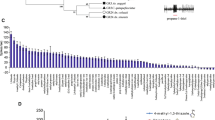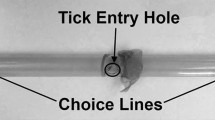Summary
Wall-pore olfactory sensilla located in the capsule of Haller's organ on the tarsus of Amblyomma variegatum ticks bear cells responding to vertebrate breath: one of these sensilla contains a CO2-excited receptor and a second sensillum has a CO2- inhibited receptor. Each of these antagonistic CO2-receptors, which display typical phasic-tonic responses, monitors a different CO2-concentration range. The CO2-inhibited receptor is very sensitive to small concentration changes between 0 and ca. 0.2%, but variations of 0.01% around ambient (ca. 0.04%) induce the strongest frequency modulation of this receptor. An increase of just 0.001–0.002% (10–20 ppm) above a zero CO2-level already inhibits this receptor. By contrast, the CO2-excited receptor is not so sensitive to small CO2 shifts around ambient, but best monitors changes in CO2 concentrations above 0.1%. This receptor is characterized by a steep dose-response curve and a fast inactivation even at high CO2-concentrations (>2%). In a wind-tunnel, Amblyomma variegatum is activated from the resting state and attracted by CO2 concentrations of 0.04 to ca. 1%, which corresponds to the sensitivity range of its CO2-receptors. The task of perceiving the whole concentration range to which this tick is attracted would thus appear to be divided between two receptors, one sensitive to small changes around ambient and the other sensitive to the higher concentrations normally encountered when approaching a vertebrate host.
Similar content being viewed by others
References
Altner H, Sass H, Altner I (1977) Relationship between structure and function of antennal chemo-, hygro, and thermoreceptive sensilla in Periplaneta americana. Cell Tissue Res 176:389–405
Bernard J (1974) Etude électrophysiologique de récepteurs impliqués dans l'orientation vers l'hôte et dans l'acte hématophage chez un hémiptère: Triatoma infestons. Thèse Université de Rennes (France)
Bogner F (1989) Single cell recordings of antennal CO2-receptors in tsetse flies. Verh Dt Zool Ges 82:272–273
Bogner F (1990) Sensory physiological investigation of carbon dioxide receptors in Lepidoptera. J Insect Physiol 36:951–957
Bogner F, Boppré M, Ernst K-D, Boeckh J (1986) CO2 sensitive receptors on labial palps of Rhodogastria moths (Lepidoptera: Arctiidae): physiology, fine structure and central projection. J Comp Physiol A 158:741–749
Fallis AM, Raybould JN (1975) Response of two African simuliids to silhouettes and carbon dioxide. J Med Entomol 12:349–351
French FE, Kline DL (1989) 1-octen-3-ol, an effective attractant for Tabanidae (Diptera). J Med Entomol 26:459–461
Garcia R (1962) Carbon dioxide as an attractant for certain ticks (Acarina, Argasidae and Ixodidae). Ann Entomol Soc Am 14:605–606
Garcia R (1965) Collection of Dermacentor andersoni (Stiles) with carbon dioxide and its application in studies of Colorado tick virus. Am J Trop Med Hyg 14:1090–1093
Gillies MT, Wilkes TJ (1968) A comparison of the range of attraction of animal baits and of carbon dioxide for some West African mosquitoes. Bull Entomol Res 59:441–456
Gödde J (1985) Low cost storing of two electrical biosignals from DC to 20 kHz at more than 80 dB dynamic range. Pflügers Arch 403:324–327
Gödde J (1989) Vibrating glass stylets: tools for precise microsurgery on cuticular structures. J Neurosci Methods 29:77–89
Gray JS (1985) A carbon dioxide trap for prolonged sampling of Ixodes ricinus L. populations. Exp Appl Acarol 1:35–44
Guglielmone AA, Moorhouse DE, Wolf G (1985) Attraction to carbon dioxide of unfed stages of Amblyomma triguttatum triguttatum Koch, under field conditions. Acarologia 26:123–129
Hess E, Loftus R (1984) Warm and cold receptors of two sensilla on the foreleg tarsi of the tropical bont tick Amblyomma variegatum. J Comp Physiol A 155:187–195
Hess E, Vlimant M (1982) The tarsal sensory system of Amblyomma variegatum Fabricius (Ixodidae, Metastriata). I. Wall pore and terminal pore sensilla. Rev Suisse Zool 89:713–729
Hess E, Vlimant M (1983) The tarsal sensory system of Amblyomma variegatum Fabricius (Ixodidae, Metastriata). III. Mapping of sensory hairs and evolution of the relative importance of sensory modalities during post-embryonic development. Rev Suisse Zool 90:887–897
Hess E, Vlimant M (1986) Leg sense organs of ticks. In: Sauer JR, Hair JA (eds) Morphology, physiology, and behavioural biology of ticks. Ellis Horwood, Chicester, pp 361–390
Hindley E, Merriman G (1912) The sensory perception of Argas persicus (Oken). Parasitology 5:203–216
Holsher KH, Gearhart HL, Barker RW (1980) Electrophysiological responses of three tick species to carbon dioxide in the laboratory and field. Ann Entomol Soc Am 73:288–292
Kellogg FE (1970) Water vapour and carbon dioxide receptors in Aedes aegypti. J Insect Physiol 16:99–108
Lees AD (1948) The sensory physiology of the sheep tick Ixodes ricinus. J Exp Biol 25:145–207
Nevill EM (1964) The role of carbon dioxide as a stimulant and attractant to the sand tampan Ornithodoros savigny (Audouin). Onderstepoort J Vet Res 31:59–68
Norval Rai, Yunker CE, Butler JF (1987) Field sampling of unfed adults of Amblyomma hebraeum Koch. Exp Appl Acarol 3:213–217
Norval RAI, Yunker CE, Gibson JD, Deem SLD (1988) Field sampling of unfed nymphs of Amblyomma hebraeum. Exp Appl Acarol 4:173–177
Osbrink WLA, Rust MK (1985) Cat flea (Siphonaptera: Pulicidae): Factors influencing host-finding behavior in the laboratory. Ann Entomol Soc Am 78:29–34
Palade GE (1952) A study of fixation for electron microscopy. J Exp Med 95:285
Sabatini DD, Bensch KG, Barrnett RJ (1963) Cytochemistry and electron microscopy. The preservation of cellular ultrastructure and enzymatic activity by aldehyde fixation. J Cell Biol 17:19–58
Sauer JR, Hair JA, Houts MS (1974) Chemo-attraction in the lone star tick (Acarina: Ixodidae). 2. Responses to various concentrations of CO2. Ann Entomol Soc Am 67:150–152
Sinitsina EE (1974) Electrophysiological reactions of the neurons of the Haller's organ to the odour stimuli in the tick Hyalomma asiaticum. Parazitologiya 8:223–226
Smith JJB, Mitchell BK, Rolseth BM, Whitehead AT, Alben PJ (1990) SAPID tools: microcomputer programs for analysis of multi-unit nerve recordings. Chem Senses 15:253–270
Stämpfli N (1987) Etude des facteurs intervenant dans la phase initiale du comportement de recherche de l'hôte, chez la tique, Amblyomma variegatum, Fabricius 1794 (Acarina: Ixodidae). Thèse Université de Neuchâtel
Stange G (1974) Linear relation between stimulus concentration and primary transduction process in insect CO2-receptors. In: Denton DA, Coghan JP (eds) Olfaction and Taste V. Pergamon Press, London, pp 207–211
Steullet P, Guerin PM (1992) Perception of breath components by the tropical bont tick Amblyomma variegatum Fabricius (Ixodidae). II. Sulfide-receptors. J Comp Physiol A 170:677–685
Turner DA (1971) Olfactory perception of live hosts and carbon dioxide by the tsetse fly Glossina morsitans orientalis Vanderplank. Bull Entomol Res 61:75–96
Waladde SM, Rice MJ (1982) The sensory basis of tick feeding behaviour. In: Obenchain FD, Galun R (eds) Physiology of ticks. Pergamon Press, Oxford New York Toronto, pp 71–118
Warnes ML, Finlayson LH (1985) Responses of the stable fly, Stomoxys calcitrans (L.) (Diptera: Muscidae) to carbon dioxide and host odours. 2. Orientation. Bull Entomol Res 75:717–727
Warnes ML, Finlayson LH (1986) Electroantennogram responses of the stable fly, Stomoxys calcitrans, to carbon dioxide and other odours. Physiol Entomol 11:469–473
Wilson JG, Kinzer DR, Sauer JR, Hair JA (1972) Chemoattraction of the lone star tick (Acarina, Ixodidae). I. Response of different developmental stages to carbon dioxide administered via traps. J Med Entomol 9:245–252
Author information
Authors and Affiliations
Rights and permissions
About this article
Cite this article
Steullet, P., Guerin, P.M. Perception of breath components by the tropical bont tick, Amblyomma variegatum Fabricius (Ixodidae). J Comp Physiol A 170, 665–676 (1992). https://doi.org/10.1007/BF00198976
Accepted:
Issue Date:
DOI: https://doi.org/10.1007/BF00198976




